Project Report: Analyzing Diversity Programs at Cambrew Brewery
VerifiedAdded on 2023/01/17
|15
|4946
|98
Project
AI Summary
This project report examines diversity programs within organizations, using Cambrew Brewery as a case study. It begins with an introduction to diversity programs, emphasizing their importance in attracting and retaining employees and fostering a positive organizational culture. The rationale highlights the project's aim to understand the objectives, benefits, and costs associated with diversity programs. A literature review defines diversity, diversity programs, and their benefits, such as improved brand image, increased profitability, better decision-making, and reduced employee turnover. The report also addresses the potential costs of diversity programs, including legal compliance, cash expenses, and opportunity costs, and outlines challenges faced during implementation. The project concludes with recommendations for improving diversity initiatives within the organization, drawing on theoretical frameworks and practical strategies to overcome challenges and maximize the benefits of diversity programs.
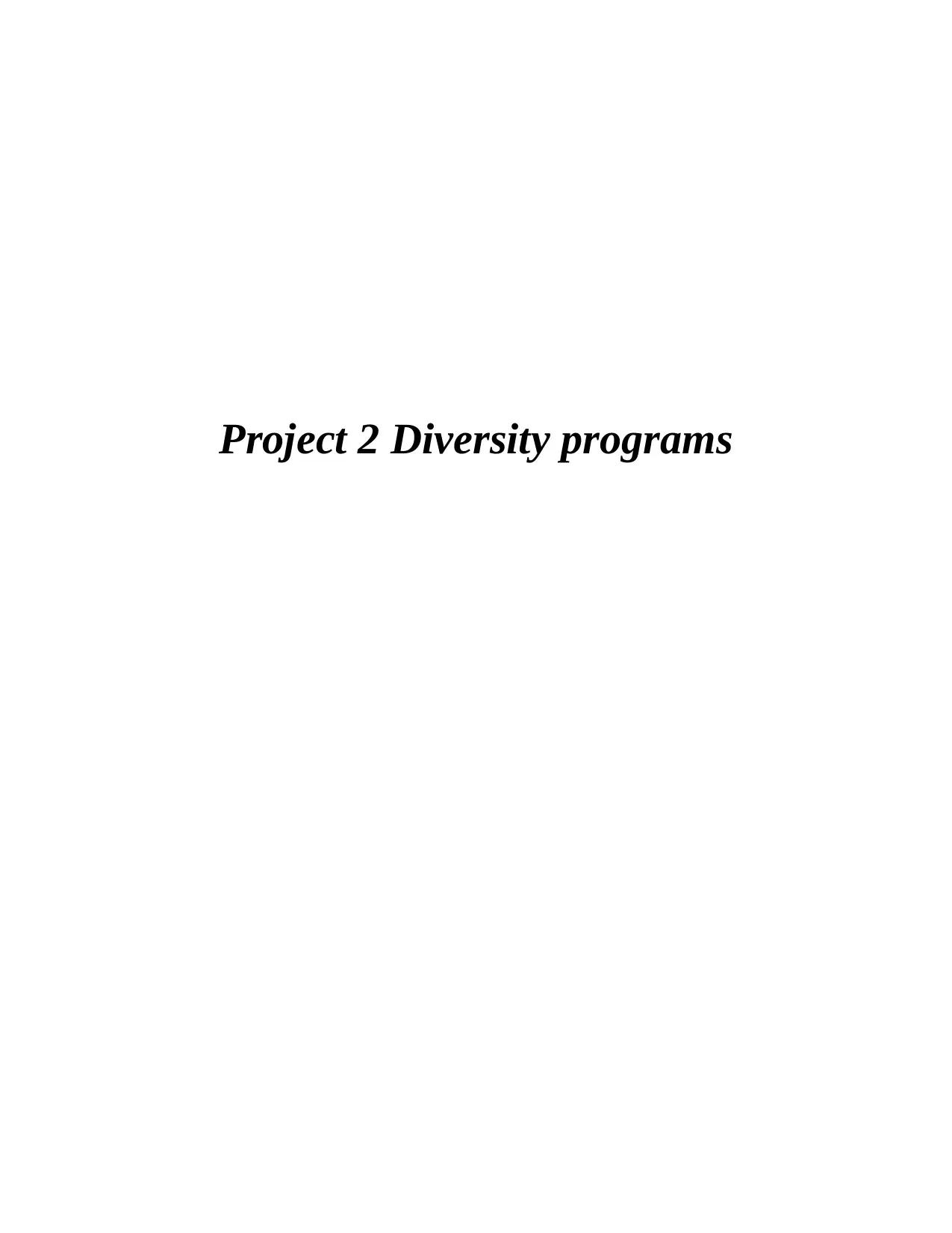
Project 2 Diversity programs
Paraphrase This Document
Need a fresh take? Get an instant paraphrase of this document with our AI Paraphraser
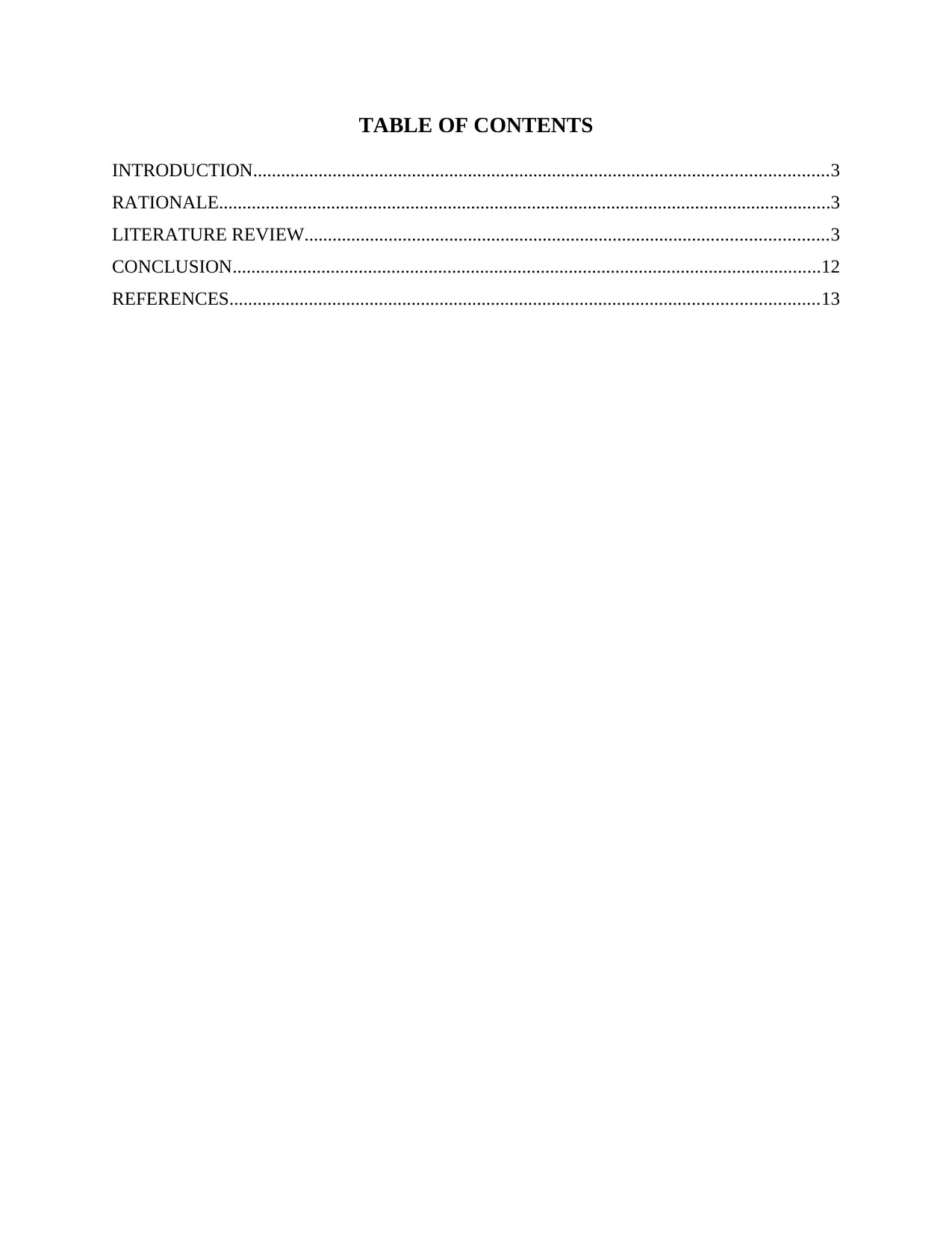
TABLE OF CONTENTS
INTRODUCTION...........................................................................................................................3
RATIONALE...................................................................................................................................3
LITERATURE REVIEW................................................................................................................3
CONCLUSION..............................................................................................................................12
REFERENCES..............................................................................................................................13
INTRODUCTION...........................................................................................................................3
RATIONALE...................................................................................................................................3
LITERATURE REVIEW................................................................................................................3
CONCLUSION..............................................................................................................................12
REFERENCES..............................................................................................................................13
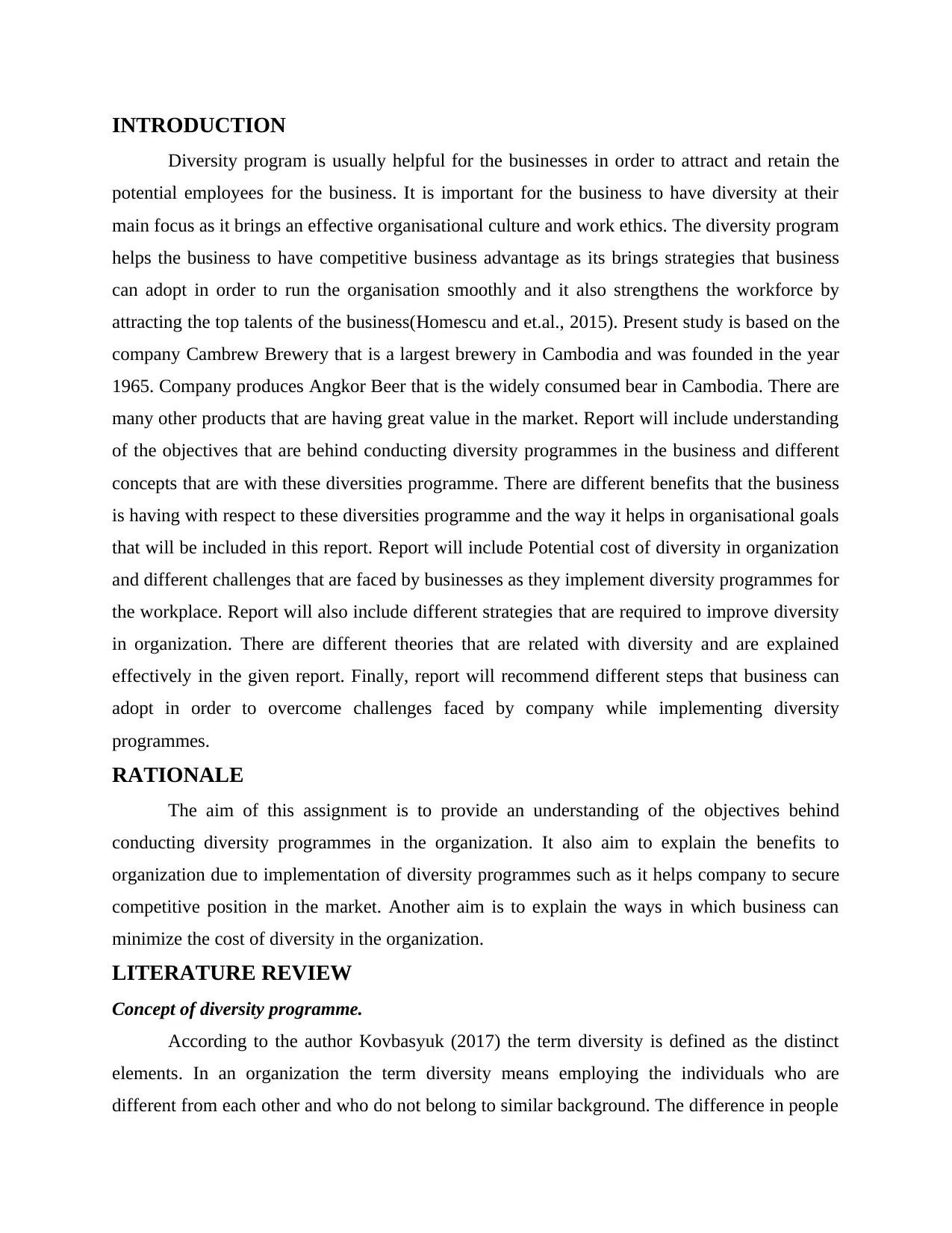
INTRODUCTION
Diversity program is usually helpful for the businesses in order to attract and retain the
potential employees for the business. It is important for the business to have diversity at their
main focus as it brings an effective organisational culture and work ethics. The diversity program
helps the business to have competitive business advantage as its brings strategies that business
can adopt in order to run the organisation smoothly and it also strengthens the workforce by
attracting the top talents of the business(Homescu and et.al., 2015). Present study is based on the
company Cambrew Brewery that is a largest brewery in Cambodia and was founded in the year
1965. Company produces Angkor Beer that is the widely consumed bear in Cambodia. There are
many other products that are having great value in the market. Report will include understanding
of the objectives that are behind conducting diversity programmes in the business and different
concepts that are with these diversities programme. There are different benefits that the business
is having with respect to these diversities programme and the way it helps in organisational goals
that will be included in this report. Report will include Potential cost of diversity in organization
and different challenges that are faced by businesses as they implement diversity programmes for
the workplace. Report will also include different strategies that are required to improve diversity
in organization. There are different theories that are related with diversity and are explained
effectively in the given report. Finally, report will recommend different steps that business can
adopt in order to overcome challenges faced by company while implementing diversity
programmes.
RATIONALE
The aim of this assignment is to provide an understanding of the objectives behind
conducting diversity programmes in the organization. It also aim to explain the benefits to
organization due to implementation of diversity programmes such as it helps company to secure
competitive position in the market. Another aim is to explain the ways in which business can
minimize the cost of diversity in the organization.
LITERATURE REVIEW
Concept of diversity programme.
According to the author Kovbasyuk (2017) the term diversity is defined as the distinct
elements. In an organization the term diversity means employing the individuals who are
different from each other and who do not belong to similar background. The difference in people
Diversity program is usually helpful for the businesses in order to attract and retain the
potential employees for the business. It is important for the business to have diversity at their
main focus as it brings an effective organisational culture and work ethics. The diversity program
helps the business to have competitive business advantage as its brings strategies that business
can adopt in order to run the organisation smoothly and it also strengthens the workforce by
attracting the top talents of the business(Homescu and et.al., 2015). Present study is based on the
company Cambrew Brewery that is a largest brewery in Cambodia and was founded in the year
1965. Company produces Angkor Beer that is the widely consumed bear in Cambodia. There are
many other products that are having great value in the market. Report will include understanding
of the objectives that are behind conducting diversity programmes in the business and different
concepts that are with these diversities programme. There are different benefits that the business
is having with respect to these diversities programme and the way it helps in organisational goals
that will be included in this report. Report will include Potential cost of diversity in organization
and different challenges that are faced by businesses as they implement diversity programmes for
the workplace. Report will also include different strategies that are required to improve diversity
in organization. There are different theories that are related with diversity and are explained
effectively in the given report. Finally, report will recommend different steps that business can
adopt in order to overcome challenges faced by company while implementing diversity
programmes.
RATIONALE
The aim of this assignment is to provide an understanding of the objectives behind
conducting diversity programmes in the organization. It also aim to explain the benefits to
organization due to implementation of diversity programmes such as it helps company to secure
competitive position in the market. Another aim is to explain the ways in which business can
minimize the cost of diversity in the organization.
LITERATURE REVIEW
Concept of diversity programme.
According to the author Kovbasyuk (2017) the term diversity is defined as the distinct
elements. In an organization the term diversity means employing the individuals who are
different from each other and who do not belong to similar background. The difference in people
⊘ This is a preview!⊘
Do you want full access?
Subscribe today to unlock all pages.

Trusted by 1+ million students worldwide
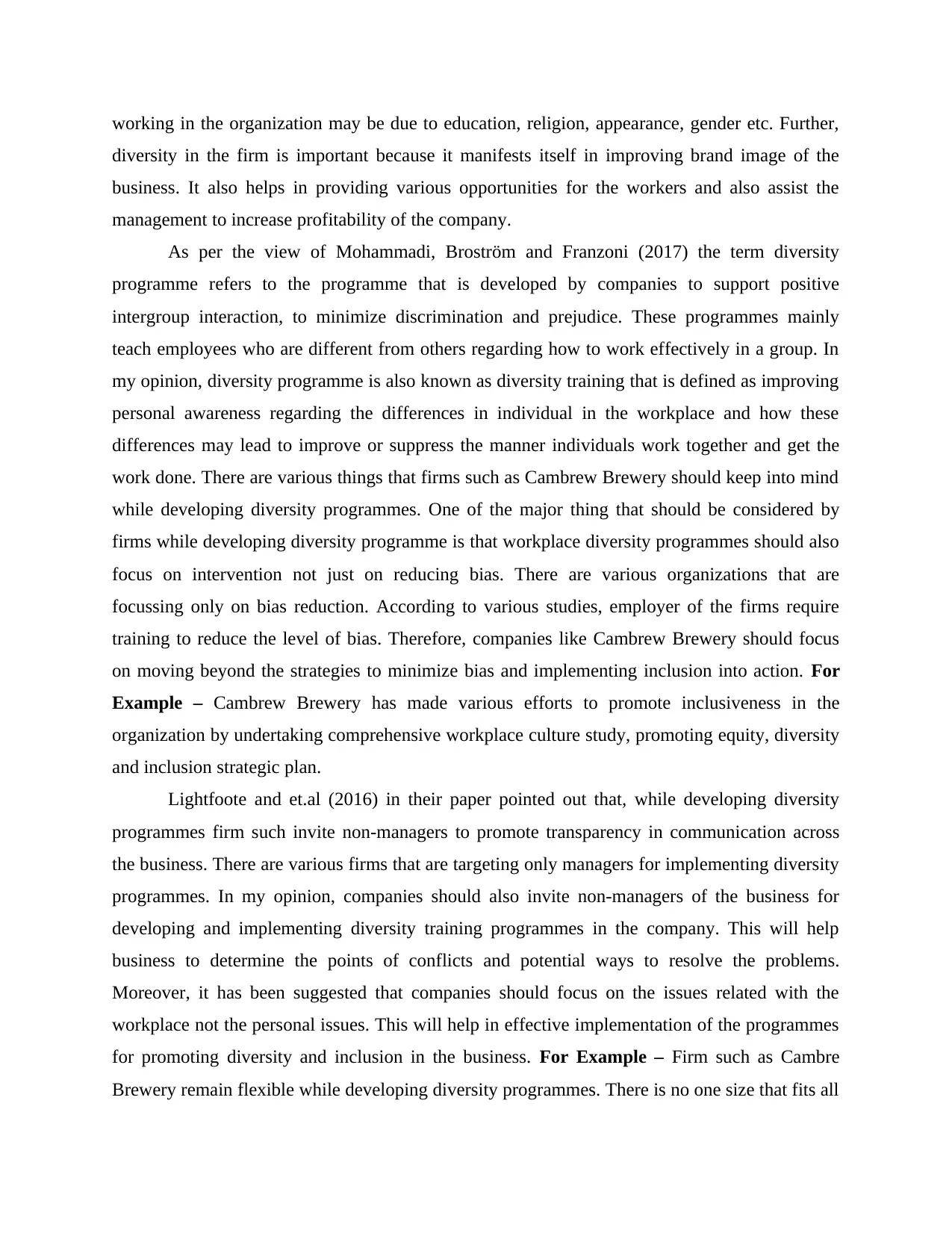
working in the organization may be due to education, religion, appearance, gender etc. Further,
diversity in the firm is important because it manifests itself in improving brand image of the
business. It also helps in providing various opportunities for the workers and also assist the
management to increase profitability of the company.
As per the view of Mohammadi, Broström and Franzoni (2017) the term diversity
programme refers to the programme that is developed by companies to support positive
intergroup interaction, to minimize discrimination and prejudice. These programmes mainly
teach employees who are different from others regarding how to work effectively in a group. In
my opinion, diversity programme is also known as diversity training that is defined as improving
personal awareness regarding the differences in individual in the workplace and how these
differences may lead to improve or suppress the manner individuals work together and get the
work done. There are various things that firms such as Cambrew Brewery should keep into mind
while developing diversity programmes. One of the major thing that should be considered by
firms while developing diversity programme is that workplace diversity programmes should also
focus on intervention not just on reducing bias. There are various organizations that are
focussing only on bias reduction. According to various studies, employer of the firms require
training to reduce the level of bias. Therefore, companies like Cambrew Brewery should focus
on moving beyond the strategies to minimize bias and implementing inclusion into action. For
Example – Cambrew Brewery has made various efforts to promote inclusiveness in the
organization by undertaking comprehensive workplace culture study, promoting equity, diversity
and inclusion strategic plan.
Lightfoote and et.al (2016) in their paper pointed out that, while developing diversity
programmes firm such invite non-managers to promote transparency in communication across
the business. There are various firms that are targeting only managers for implementing diversity
programmes. In my opinion, companies should also invite non-managers of the business for
developing and implementing diversity training programmes in the company. This will help
business to determine the points of conflicts and potential ways to resolve the problems.
Moreover, it has been suggested that companies should focus on the issues related with the
workplace not the personal issues. This will help in effective implementation of the programmes
for promoting diversity and inclusion in the business. For Example – Firm such as Cambre
Brewery remain flexible while developing diversity programmes. There is no one size that fits all
diversity in the firm is important because it manifests itself in improving brand image of the
business. It also helps in providing various opportunities for the workers and also assist the
management to increase profitability of the company.
As per the view of Mohammadi, Broström and Franzoni (2017) the term diversity
programme refers to the programme that is developed by companies to support positive
intergroup interaction, to minimize discrimination and prejudice. These programmes mainly
teach employees who are different from others regarding how to work effectively in a group. In
my opinion, diversity programme is also known as diversity training that is defined as improving
personal awareness regarding the differences in individual in the workplace and how these
differences may lead to improve or suppress the manner individuals work together and get the
work done. There are various things that firms such as Cambrew Brewery should keep into mind
while developing diversity programmes. One of the major thing that should be considered by
firms while developing diversity programme is that workplace diversity programmes should also
focus on intervention not just on reducing bias. There are various organizations that are
focussing only on bias reduction. According to various studies, employer of the firms require
training to reduce the level of bias. Therefore, companies like Cambrew Brewery should focus
on moving beyond the strategies to minimize bias and implementing inclusion into action. For
Example – Cambrew Brewery has made various efforts to promote inclusiveness in the
organization by undertaking comprehensive workplace culture study, promoting equity, diversity
and inclusion strategic plan.
Lightfoote and et.al (2016) in their paper pointed out that, while developing diversity
programmes firm such invite non-managers to promote transparency in communication across
the business. There are various firms that are targeting only managers for implementing diversity
programmes. In my opinion, companies should also invite non-managers of the business for
developing and implementing diversity training programmes in the company. This will help
business to determine the points of conflicts and potential ways to resolve the problems.
Moreover, it has been suggested that companies should focus on the issues related with the
workplace not the personal issues. This will help in effective implementation of the programmes
for promoting diversity and inclusion in the business. For Example – Firm such as Cambre
Brewery remain flexible while developing diversity programmes. There is no one size that fits all
Paraphrase This Document
Need a fresh take? Get an instant paraphrase of this document with our AI Paraphraser
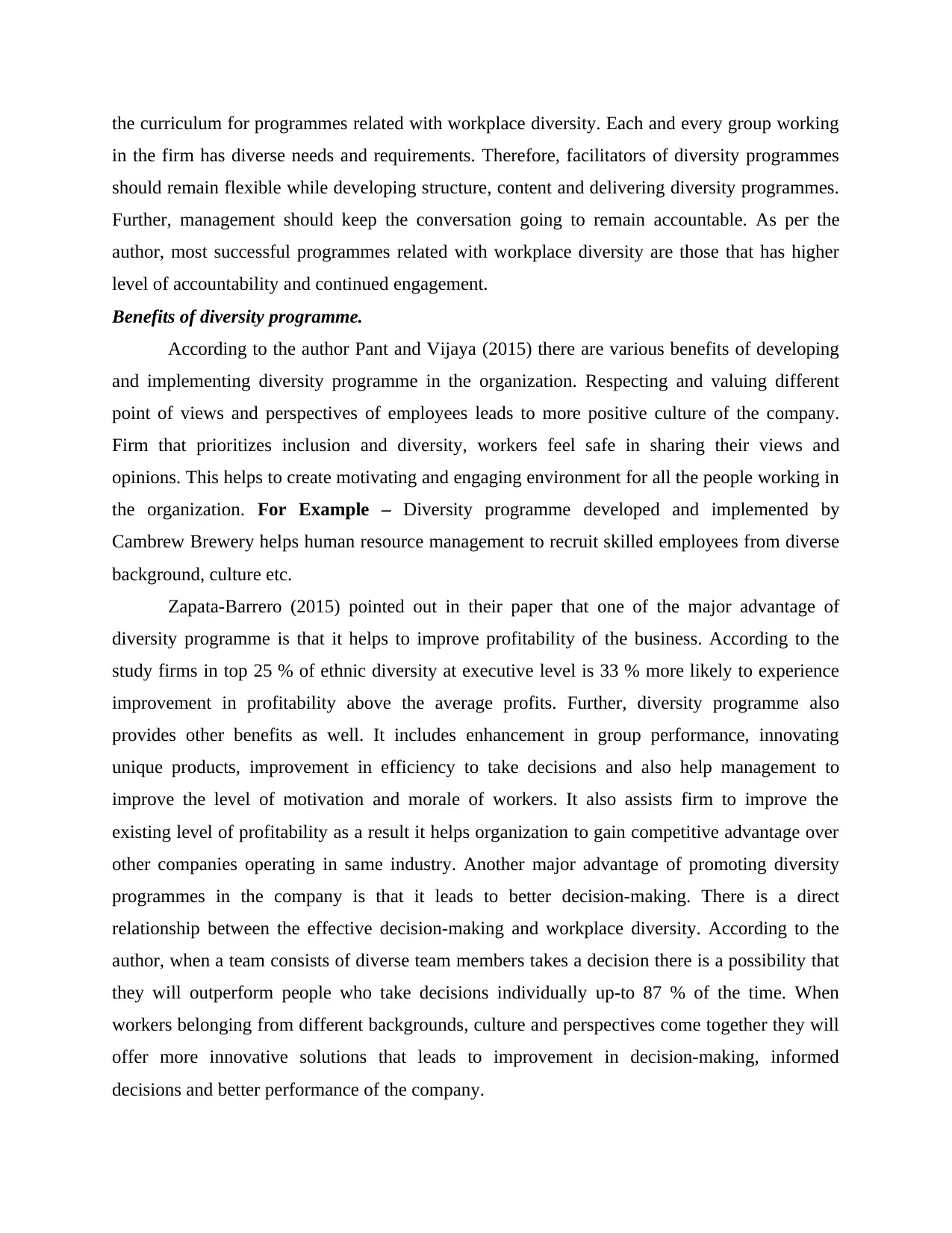
the curriculum for programmes related with workplace diversity. Each and every group working
in the firm has diverse needs and requirements. Therefore, facilitators of diversity programmes
should remain flexible while developing structure, content and delivering diversity programmes.
Further, management should keep the conversation going to remain accountable. As per the
author, most successful programmes related with workplace diversity are those that has higher
level of accountability and continued engagement.
Benefits of diversity programme.
According to the author Pant and Vijaya (2015) there are various benefits of developing
and implementing diversity programme in the organization. Respecting and valuing different
point of views and perspectives of employees leads to more positive culture of the company.
Firm that prioritizes inclusion and diversity, workers feel safe in sharing their views and
opinions. This helps to create motivating and engaging environment for all the people working in
the organization. For Example – Diversity programme developed and implemented by
Cambrew Brewery helps human resource management to recruit skilled employees from diverse
background, culture etc.
Zapata-Barrero (2015) pointed out in their paper that one of the major advantage of
diversity programme is that it helps to improve profitability of the business. According to the
study firms in top 25 % of ethnic diversity at executive level is 33 % more likely to experience
improvement in profitability above the average profits. Further, diversity programme also
provides other benefits as well. It includes enhancement in group performance, innovating
unique products, improvement in efficiency to take decisions and also help management to
improve the level of motivation and morale of workers. It also assists firm to improve the
existing level of profitability as a result it helps organization to gain competitive advantage over
other companies operating in same industry. Another major advantage of promoting diversity
programmes in the company is that it leads to better decision-making. There is a direct
relationship between the effective decision-making and workplace diversity. According to the
author, when a team consists of diverse team members takes a decision there is a possibility that
they will outperform people who take decisions individually up-to 87 % of the time. When
workers belonging from different backgrounds, culture and perspectives come together they will
offer more innovative solutions that leads to improvement in decision-making, informed
decisions and better performance of the company.
in the firm has diverse needs and requirements. Therefore, facilitators of diversity programmes
should remain flexible while developing structure, content and delivering diversity programmes.
Further, management should keep the conversation going to remain accountable. As per the
author, most successful programmes related with workplace diversity are those that has higher
level of accountability and continued engagement.
Benefits of diversity programme.
According to the author Pant and Vijaya (2015) there are various benefits of developing
and implementing diversity programme in the organization. Respecting and valuing different
point of views and perspectives of employees leads to more positive culture of the company.
Firm that prioritizes inclusion and diversity, workers feel safe in sharing their views and
opinions. This helps to create motivating and engaging environment for all the people working in
the organization. For Example – Diversity programme developed and implemented by
Cambrew Brewery helps human resource management to recruit skilled employees from diverse
background, culture etc.
Zapata-Barrero (2015) pointed out in their paper that one of the major advantage of
diversity programme is that it helps to improve profitability of the business. According to the
study firms in top 25 % of ethnic diversity at executive level is 33 % more likely to experience
improvement in profitability above the average profits. Further, diversity programme also
provides other benefits as well. It includes enhancement in group performance, innovating
unique products, improvement in efficiency to take decisions and also help management to
improve the level of motivation and morale of workers. It also assists firm to improve the
existing level of profitability as a result it helps organization to gain competitive advantage over
other companies operating in same industry. Another major advantage of promoting diversity
programmes in the company is that it leads to better decision-making. There is a direct
relationship between the effective decision-making and workplace diversity. According to the
author, when a team consists of diverse team members takes a decision there is a possibility that
they will outperform people who take decisions individually up-to 87 % of the time. When
workers belonging from different backgrounds, culture and perspectives come together they will
offer more innovative solutions that leads to improvement in decision-making, informed
decisions and better performance of the company.
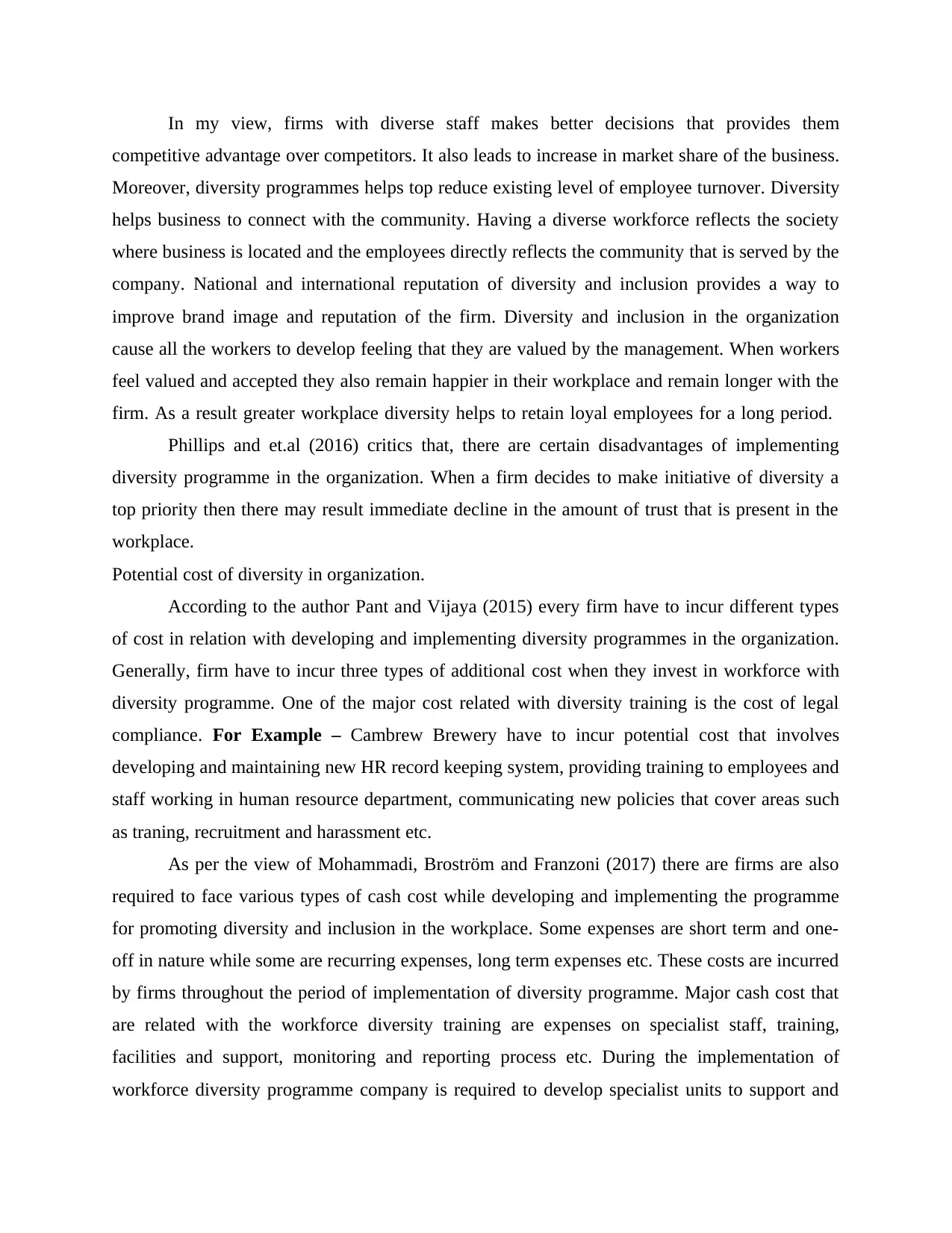
In my view, firms with diverse staff makes better decisions that provides them
competitive advantage over competitors. It also leads to increase in market share of the business.
Moreover, diversity programmes helps top reduce existing level of employee turnover. Diversity
helps business to connect with the community. Having a diverse workforce reflects the society
where business is located and the employees directly reflects the community that is served by the
company. National and international reputation of diversity and inclusion provides a way to
improve brand image and reputation of the firm. Diversity and inclusion in the organization
cause all the workers to develop feeling that they are valued by the management. When workers
feel valued and accepted they also remain happier in their workplace and remain longer with the
firm. As a result greater workplace diversity helps to retain loyal employees for a long period.
Phillips and et.al (2016) critics that, there are certain disadvantages of implementing
diversity programme in the organization. When a firm decides to make initiative of diversity a
top priority then there may result immediate decline in the amount of trust that is present in the
workplace.
Potential cost of diversity in organization.
According to the author Pant and Vijaya (2015) every firm have to incur different types
of cost in relation with developing and implementing diversity programmes in the organization.
Generally, firm have to incur three types of additional cost when they invest in workforce with
diversity programme. One of the major cost related with diversity training is the cost of legal
compliance. For Example – Cambrew Brewery have to incur potential cost that involves
developing and maintaining new HR record keeping system, providing training to employees and
staff working in human resource department, communicating new policies that cover areas such
as traning, recruitment and harassment etc.
As per the view of Mohammadi, Broström and Franzoni (2017) there are firms are also
required to face various types of cash cost while developing and implementing the programme
for promoting diversity and inclusion in the workplace. Some expenses are short term and one-
off in nature while some are recurring expenses, long term expenses etc. These costs are incurred
by firms throughout the period of implementation of diversity programme. Major cash cost that
are related with the workforce diversity training are expenses on specialist staff, training,
facilities and support, monitoring and reporting process etc. During the implementation of
workforce diversity programme company is required to develop specialist units to support and
competitive advantage over competitors. It also leads to increase in market share of the business.
Moreover, diversity programmes helps top reduce existing level of employee turnover. Diversity
helps business to connect with the community. Having a diverse workforce reflects the society
where business is located and the employees directly reflects the community that is served by the
company. National and international reputation of diversity and inclusion provides a way to
improve brand image and reputation of the firm. Diversity and inclusion in the organization
cause all the workers to develop feeling that they are valued by the management. When workers
feel valued and accepted they also remain happier in their workplace and remain longer with the
firm. As a result greater workplace diversity helps to retain loyal employees for a long period.
Phillips and et.al (2016) critics that, there are certain disadvantages of implementing
diversity programme in the organization. When a firm decides to make initiative of diversity a
top priority then there may result immediate decline in the amount of trust that is present in the
workplace.
Potential cost of diversity in organization.
According to the author Pant and Vijaya (2015) every firm have to incur different types
of cost in relation with developing and implementing diversity programmes in the organization.
Generally, firm have to incur three types of additional cost when they invest in workforce with
diversity programme. One of the major cost related with diversity training is the cost of legal
compliance. For Example – Cambrew Brewery have to incur potential cost that involves
developing and maintaining new HR record keeping system, providing training to employees and
staff working in human resource department, communicating new policies that cover areas such
as traning, recruitment and harassment etc.
As per the view of Mohammadi, Broström and Franzoni (2017) there are firms are also
required to face various types of cash cost while developing and implementing the programme
for promoting diversity and inclusion in the workplace. Some expenses are short term and one-
off in nature while some are recurring expenses, long term expenses etc. These costs are incurred
by firms throughout the period of implementation of diversity programme. Major cash cost that
are related with the workforce diversity training are expenses on specialist staff, training,
facilities and support, monitoring and reporting process etc. During the implementation of
workforce diversity programme company is required to develop specialist units to support and
⊘ This is a preview!⊘
Do you want full access?
Subscribe today to unlock all pages.

Trusted by 1+ million students worldwide
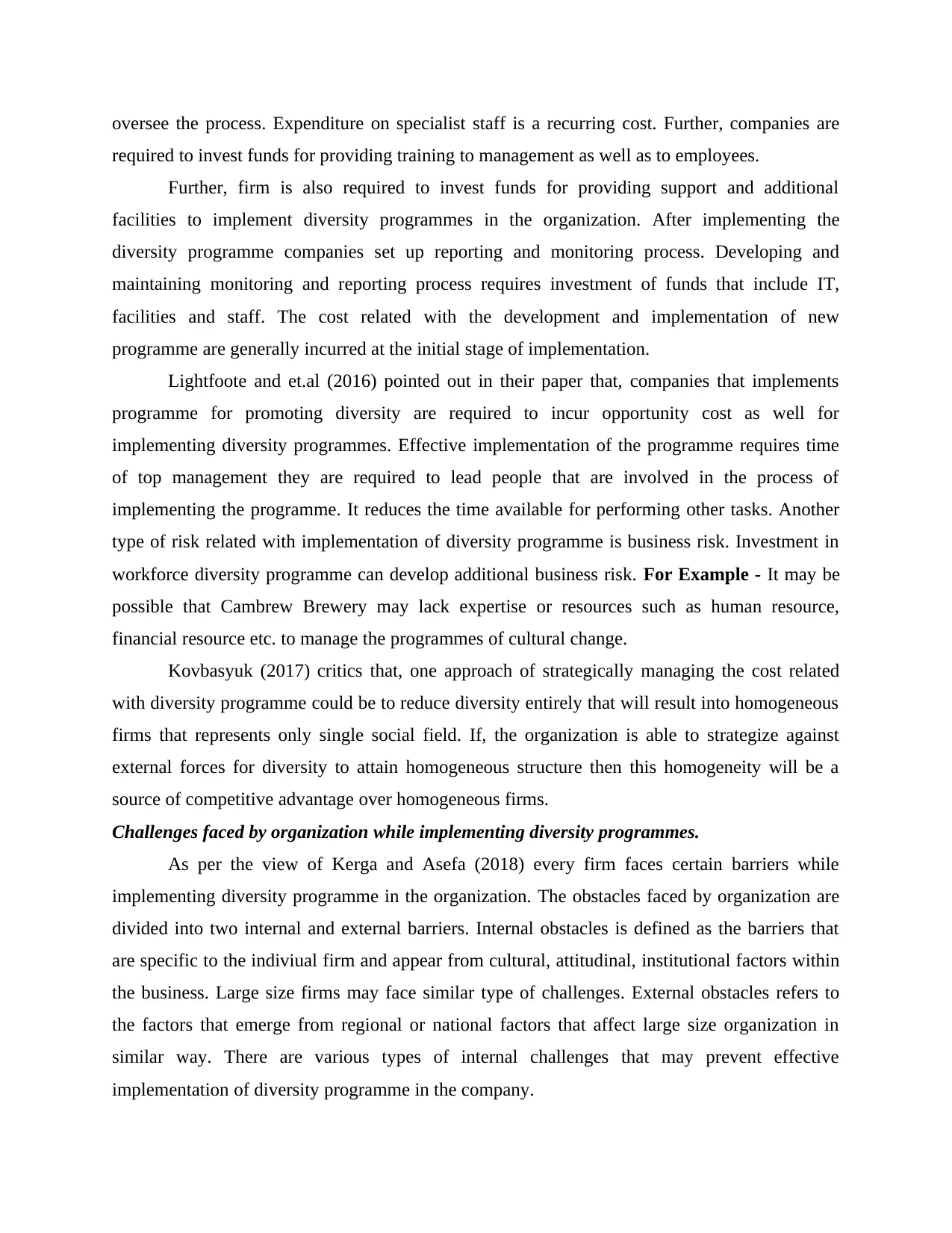
oversee the process. Expenditure on specialist staff is a recurring cost. Further, companies are
required to invest funds for providing training to management as well as to employees.
Further, firm is also required to invest funds for providing support and additional
facilities to implement diversity programmes in the organization. After implementing the
diversity programme companies set up reporting and monitoring process. Developing and
maintaining monitoring and reporting process requires investment of funds that include IT,
facilities and staff. The cost related with the development and implementation of new
programme are generally incurred at the initial stage of implementation.
Lightfoote and et.al (2016) pointed out in their paper that, companies that implements
programme for promoting diversity are required to incur opportunity cost as well for
implementing diversity programmes. Effective implementation of the programme requires time
of top management they are required to lead people that are involved in the process of
implementing the programme. It reduces the time available for performing other tasks. Another
type of risk related with implementation of diversity programme is business risk. Investment in
workforce diversity programme can develop additional business risk. For Example - It may be
possible that Cambrew Brewery may lack expertise or resources such as human resource,
financial resource etc. to manage the programmes of cultural change.
Kovbasyuk (2017) critics that, one approach of strategically managing the cost related
with diversity programme could be to reduce diversity entirely that will result into homogeneous
firms that represents only single social field. If, the organization is able to strategize against
external forces for diversity to attain homogeneous structure then this homogeneity will be a
source of competitive advantage over homogeneous firms.
Challenges faced by organization while implementing diversity programmes.
As per the view of Kerga and Asefa (2018) every firm faces certain barriers while
implementing diversity programme in the organization. The obstacles faced by organization are
divided into two internal and external barriers. Internal obstacles is defined as the barriers that
are specific to the indiviual firm and appear from cultural, attitudinal, institutional factors within
the business. Large size firms may face similar type of challenges. External obstacles refers to
the factors that emerge from regional or national factors that affect large size organization in
similar way. There are various types of internal challenges that may prevent effective
implementation of diversity programme in the company.
required to invest funds for providing training to management as well as to employees.
Further, firm is also required to invest funds for providing support and additional
facilities to implement diversity programmes in the organization. After implementing the
diversity programme companies set up reporting and monitoring process. Developing and
maintaining monitoring and reporting process requires investment of funds that include IT,
facilities and staff. The cost related with the development and implementation of new
programme are generally incurred at the initial stage of implementation.
Lightfoote and et.al (2016) pointed out in their paper that, companies that implements
programme for promoting diversity are required to incur opportunity cost as well for
implementing diversity programmes. Effective implementation of the programme requires time
of top management they are required to lead people that are involved in the process of
implementing the programme. It reduces the time available for performing other tasks. Another
type of risk related with implementation of diversity programme is business risk. Investment in
workforce diversity programme can develop additional business risk. For Example - It may be
possible that Cambrew Brewery may lack expertise or resources such as human resource,
financial resource etc. to manage the programmes of cultural change.
Kovbasyuk (2017) critics that, one approach of strategically managing the cost related
with diversity programme could be to reduce diversity entirely that will result into homogeneous
firms that represents only single social field. If, the organization is able to strategize against
external forces for diversity to attain homogeneous structure then this homogeneity will be a
source of competitive advantage over homogeneous firms.
Challenges faced by organization while implementing diversity programmes.
As per the view of Kerga and Asefa (2018) every firm faces certain barriers while
implementing diversity programme in the organization. The obstacles faced by organization are
divided into two internal and external barriers. Internal obstacles is defined as the barriers that
are specific to the indiviual firm and appear from cultural, attitudinal, institutional factors within
the business. Large size firms may face similar type of challenges. External obstacles refers to
the factors that emerge from regional or national factors that affect large size organization in
similar way. There are various types of internal challenges that may prevent effective
implementation of diversity programme in the company.
Paraphrase This Document
Need a fresh take? Get an instant paraphrase of this document with our AI Paraphraser
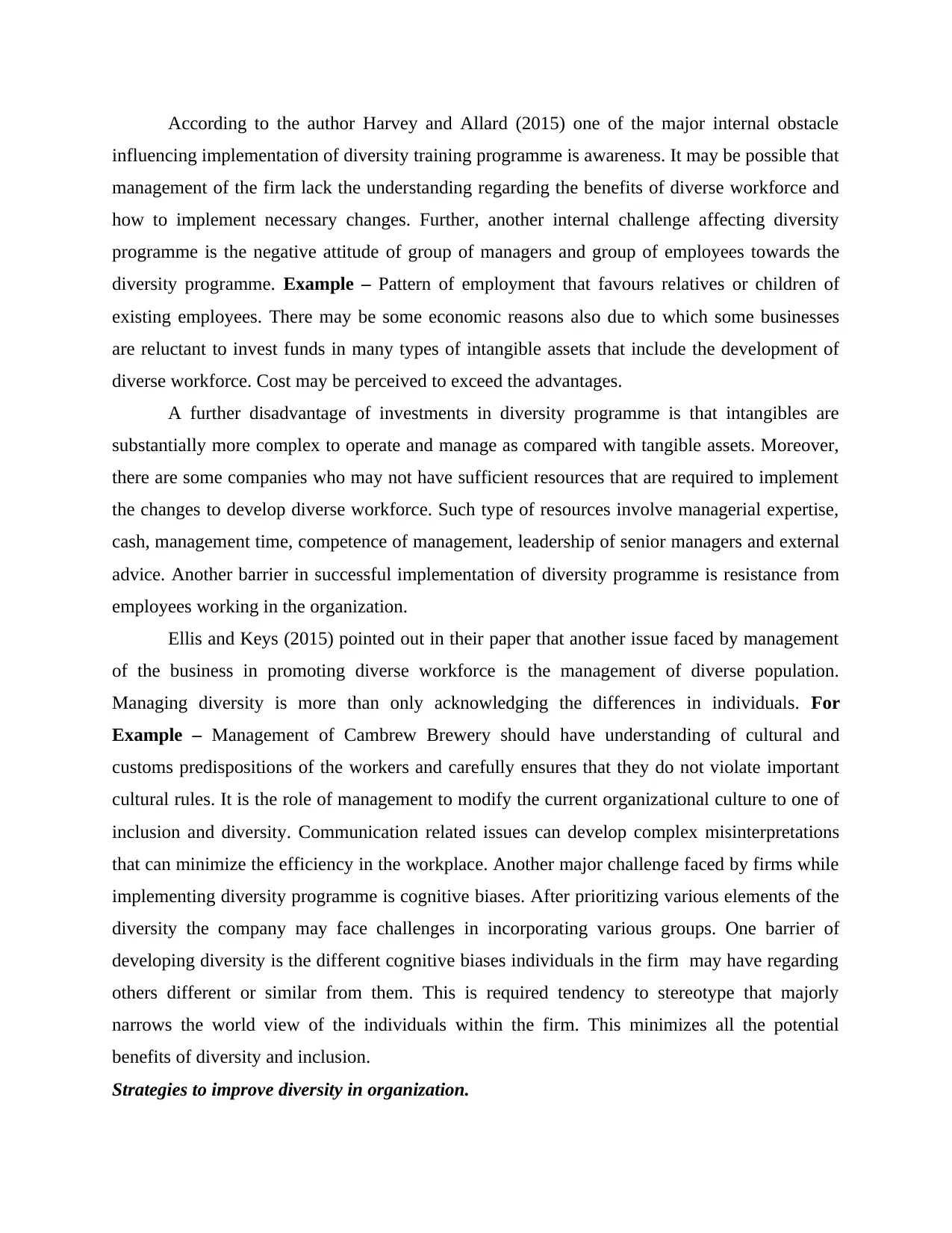
According to the author Harvey and Allard (2015) one of the major internal obstacle
influencing implementation of diversity training programme is awareness. It may be possible that
management of the firm lack the understanding regarding the benefits of diverse workforce and
how to implement necessary changes. Further, another internal challenge affecting diversity
programme is the negative attitude of group of managers and group of employees towards the
diversity programme. Example – Pattern of employment that favours relatives or children of
existing employees. There may be some economic reasons also due to which some businesses
are reluctant to invest funds in many types of intangible assets that include the development of
diverse workforce. Cost may be perceived to exceed the advantages.
A further disadvantage of investments in diversity programme is that intangibles are
substantially more complex to operate and manage as compared with tangible assets. Moreover,
there are some companies who may not have sufficient resources that are required to implement
the changes to develop diverse workforce. Such type of resources involve managerial expertise,
cash, management time, competence of management, leadership of senior managers and external
advice. Another barrier in successful implementation of diversity programme is resistance from
employees working in the organization.
Ellis and Keys (2015) pointed out in their paper that another issue faced by management
of the business in promoting diverse workforce is the management of diverse population.
Managing diversity is more than only acknowledging the differences in individuals. For
Example – Management of Cambrew Brewery should have understanding of cultural and
customs predispositions of the workers and carefully ensures that they do not violate important
cultural rules. It is the role of management to modify the current organizational culture to one of
inclusion and diversity. Communication related issues can develop complex misinterpretations
that can minimize the efficiency in the workplace. Another major challenge faced by firms while
implementing diversity programme is cognitive biases. After prioritizing various elements of the
diversity the company may face challenges in incorporating various groups. One barrier of
developing diversity is the different cognitive biases individuals in the firm may have regarding
others different or similar from them. This is required tendency to stereotype that majorly
narrows the world view of the individuals within the firm. This minimizes all the potential
benefits of diversity and inclusion.
Strategies to improve diversity in organization.
influencing implementation of diversity training programme is awareness. It may be possible that
management of the firm lack the understanding regarding the benefits of diverse workforce and
how to implement necessary changes. Further, another internal challenge affecting diversity
programme is the negative attitude of group of managers and group of employees towards the
diversity programme. Example – Pattern of employment that favours relatives or children of
existing employees. There may be some economic reasons also due to which some businesses
are reluctant to invest funds in many types of intangible assets that include the development of
diverse workforce. Cost may be perceived to exceed the advantages.
A further disadvantage of investments in diversity programme is that intangibles are
substantially more complex to operate and manage as compared with tangible assets. Moreover,
there are some companies who may not have sufficient resources that are required to implement
the changes to develop diverse workforce. Such type of resources involve managerial expertise,
cash, management time, competence of management, leadership of senior managers and external
advice. Another barrier in successful implementation of diversity programme is resistance from
employees working in the organization.
Ellis and Keys (2015) pointed out in their paper that another issue faced by management
of the business in promoting diverse workforce is the management of diverse population.
Managing diversity is more than only acknowledging the differences in individuals. For
Example – Management of Cambrew Brewery should have understanding of cultural and
customs predispositions of the workers and carefully ensures that they do not violate important
cultural rules. It is the role of management to modify the current organizational culture to one of
inclusion and diversity. Communication related issues can develop complex misinterpretations
that can minimize the efficiency in the workplace. Another major challenge faced by firms while
implementing diversity programme is cognitive biases. After prioritizing various elements of the
diversity the company may face challenges in incorporating various groups. One barrier of
developing diversity is the different cognitive biases individuals in the firm may have regarding
others different or similar from them. This is required tendency to stereotype that majorly
narrows the world view of the individuals within the firm. This minimizes all the potential
benefits of diversity and inclusion.
Strategies to improve diversity in organization.
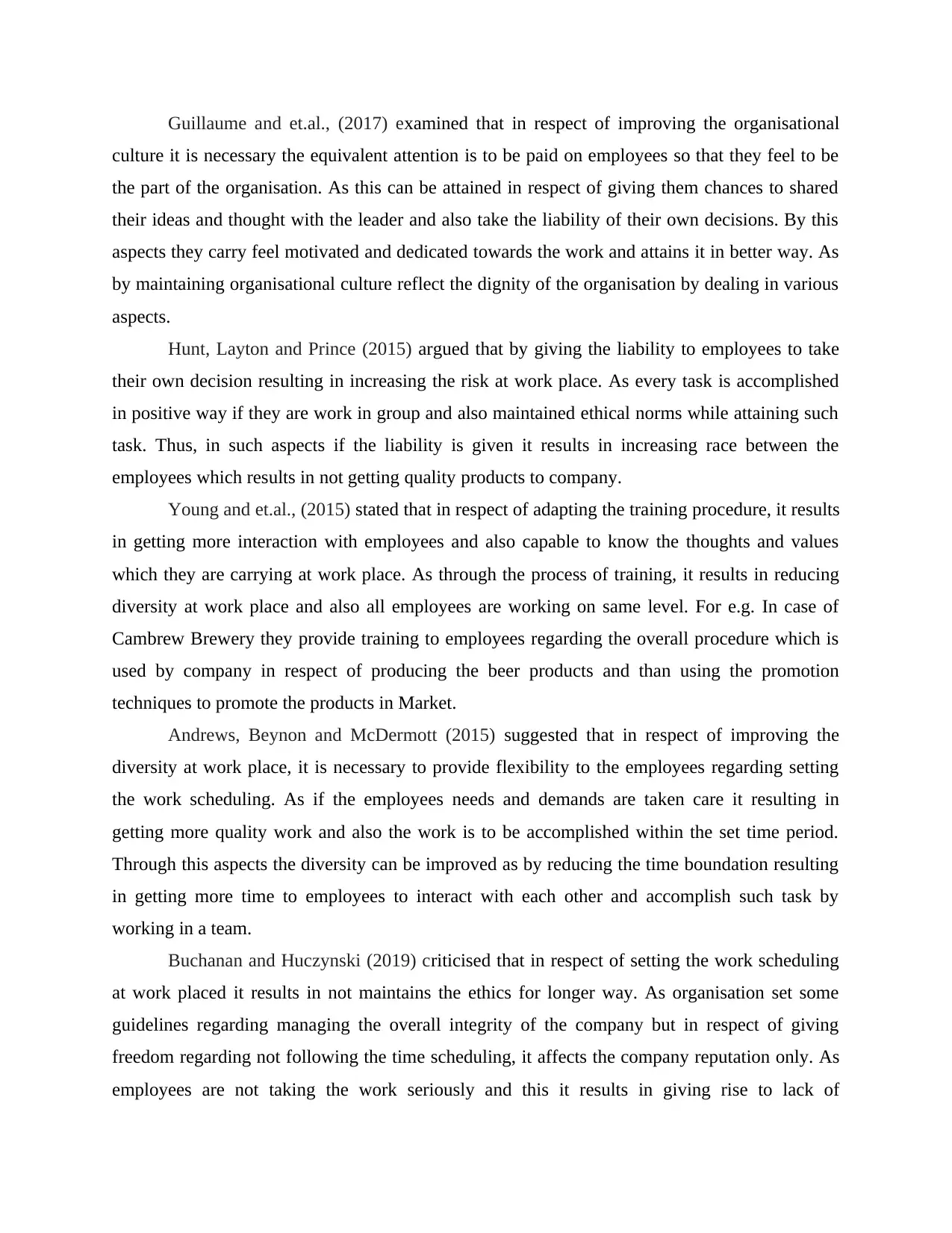
Guillaume and et.al., (2017) examined that in respect of improving the organisational
culture it is necessary the equivalent attention is to be paid on employees so that they feel to be
the part of the organisation. As this can be attained in respect of giving them chances to shared
their ideas and thought with the leader and also take the liability of their own decisions. By this
aspects they carry feel motivated and dedicated towards the work and attains it in better way. As
by maintaining organisational culture reflect the dignity of the organisation by dealing in various
aspects.
Hunt, Layton and Prince (2015) argued that by giving the liability to employees to take
their own decision resulting in increasing the risk at work place. As every task is accomplished
in positive way if they are work in group and also maintained ethical norms while attaining such
task. Thus, in such aspects if the liability is given it results in increasing race between the
employees which results in not getting quality products to company.
Young and et.al., (2015) stated that in respect of adapting the training procedure, it results
in getting more interaction with employees and also capable to know the thoughts and values
which they are carrying at work place. As through the process of training, it results in reducing
diversity at work place and also all employees are working on same level. For e.g. In case of
Cambrew Brewery they provide training to employees regarding the overall procedure which is
used by company in respect of producing the beer products and than using the promotion
techniques to promote the products in Market.
Andrews, Beynon and McDermott (2015) suggested that in respect of improving the
diversity at work place, it is necessary to provide flexibility to the employees regarding setting
the work scheduling. As if the employees needs and demands are taken care it resulting in
getting more quality work and also the work is to be accomplished within the set time period.
Through this aspects the diversity can be improved as by reducing the time boundation resulting
in getting more time to employees to interact with each other and accomplish such task by
working in a team.
Buchanan and Huczynski (2019) criticised that in respect of setting the work scheduling
at work placed it results in not maintains the ethics for longer way. As organisation set some
guidelines regarding managing the overall integrity of the company but in respect of giving
freedom regarding not following the time scheduling, it affects the company reputation only. As
employees are not taking the work seriously and this it results in giving rise to lack of
culture it is necessary the equivalent attention is to be paid on employees so that they feel to be
the part of the organisation. As this can be attained in respect of giving them chances to shared
their ideas and thought with the leader and also take the liability of their own decisions. By this
aspects they carry feel motivated and dedicated towards the work and attains it in better way. As
by maintaining organisational culture reflect the dignity of the organisation by dealing in various
aspects.
Hunt, Layton and Prince (2015) argued that by giving the liability to employees to take
their own decision resulting in increasing the risk at work place. As every task is accomplished
in positive way if they are work in group and also maintained ethical norms while attaining such
task. Thus, in such aspects if the liability is given it results in increasing race between the
employees which results in not getting quality products to company.
Young and et.al., (2015) stated that in respect of adapting the training procedure, it results
in getting more interaction with employees and also capable to know the thoughts and values
which they are carrying at work place. As through the process of training, it results in reducing
diversity at work place and also all employees are working on same level. For e.g. In case of
Cambrew Brewery they provide training to employees regarding the overall procedure which is
used by company in respect of producing the beer products and than using the promotion
techniques to promote the products in Market.
Andrews, Beynon and McDermott (2015) suggested that in respect of improving the
diversity at work place, it is necessary to provide flexibility to the employees regarding setting
the work scheduling. As if the employees needs and demands are taken care it resulting in
getting more quality work and also the work is to be accomplished within the set time period.
Through this aspects the diversity can be improved as by reducing the time boundation resulting
in getting more time to employees to interact with each other and accomplish such task by
working in a team.
Buchanan and Huczynski (2019) criticised that in respect of setting the work scheduling
at work placed it results in not maintains the ethics for longer way. As organisation set some
guidelines regarding managing the overall integrity of the company but in respect of giving
freedom regarding not following the time scheduling, it affects the company reputation only. As
employees are not taking the work seriously and this it results in giving rise to lack of
⊘ This is a preview!⊘
Do you want full access?
Subscribe today to unlock all pages.

Trusted by 1+ million students worldwide
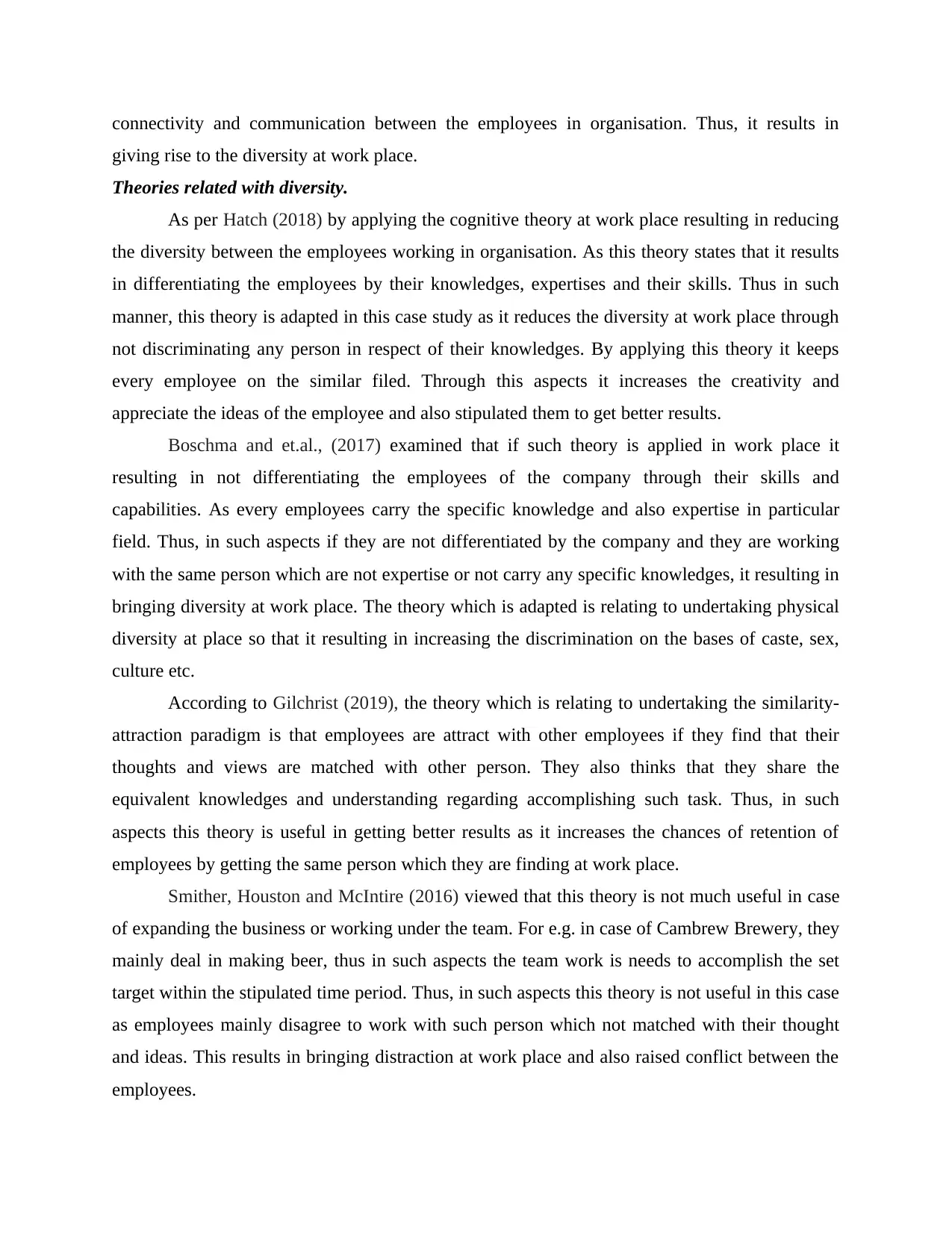
connectivity and communication between the employees in organisation. Thus, it results in
giving rise to the diversity at work place.
Theories related with diversity.
As per Hatch (2018) by applying the cognitive theory at work place resulting in reducing
the diversity between the employees working in organisation. As this theory states that it results
in differentiating the employees by their knowledges, expertises and their skills. Thus in such
manner, this theory is adapted in this case study as it reduces the diversity at work place through
not discriminating any person in respect of their knowledges. By applying this theory it keeps
every employee on the similar filed. Through this aspects it increases the creativity and
appreciate the ideas of the employee and also stipulated them to get better results.
Boschma and et.al., (2017) examined that if such theory is applied in work place it
resulting in not differentiating the employees of the company through their skills and
capabilities. As every employees carry the specific knowledge and also expertise in particular
field. Thus, in such aspects if they are not differentiated by the company and they are working
with the same person which are not expertise or not carry any specific knowledges, it resulting in
bringing diversity at work place. The theory which is adapted is relating to undertaking physical
diversity at place so that it resulting in increasing the discrimination on the bases of caste, sex,
culture etc.
According to Gilchrist (2019), the theory which is relating to undertaking the similarity-
attraction paradigm is that employees are attract with other employees if they find that their
thoughts and views are matched with other person. They also thinks that they share the
equivalent knowledges and understanding regarding accomplishing such task. Thus, in such
aspects this theory is useful in getting better results as it increases the chances of retention of
employees by getting the same person which they are finding at work place.
Smither, Houston and McIntire (2016) viewed that this theory is not much useful in case
of expanding the business or working under the team. For e.g. in case of Cambrew Brewery, they
mainly deal in making beer, thus in such aspects the team work is needs to accomplish the set
target within the stipulated time period. Thus, in such aspects this theory is not useful in this case
as employees mainly disagree to work with such person which not matched with their thought
and ideas. This results in bringing distraction at work place and also raised conflict between the
employees.
giving rise to the diversity at work place.
Theories related with diversity.
As per Hatch (2018) by applying the cognitive theory at work place resulting in reducing
the diversity between the employees working in organisation. As this theory states that it results
in differentiating the employees by their knowledges, expertises and their skills. Thus in such
manner, this theory is adapted in this case study as it reduces the diversity at work place through
not discriminating any person in respect of their knowledges. By applying this theory it keeps
every employee on the similar filed. Through this aspects it increases the creativity and
appreciate the ideas of the employee and also stipulated them to get better results.
Boschma and et.al., (2017) examined that if such theory is applied in work place it
resulting in not differentiating the employees of the company through their skills and
capabilities. As every employees carry the specific knowledge and also expertise in particular
field. Thus, in such aspects if they are not differentiated by the company and they are working
with the same person which are not expertise or not carry any specific knowledges, it resulting in
bringing diversity at work place. The theory which is adapted is relating to undertaking physical
diversity at place so that it resulting in increasing the discrimination on the bases of caste, sex,
culture etc.
According to Gilchrist (2019), the theory which is relating to undertaking the similarity-
attraction paradigm is that employees are attract with other employees if they find that their
thoughts and views are matched with other person. They also thinks that they share the
equivalent knowledges and understanding regarding accomplishing such task. Thus, in such
aspects this theory is useful in getting better results as it increases the chances of retention of
employees by getting the same person which they are finding at work place.
Smither, Houston and McIntire (2016) viewed that this theory is not much useful in case
of expanding the business or working under the team. For e.g. in case of Cambrew Brewery, they
mainly deal in making beer, thus in such aspects the team work is needs to accomplish the set
target within the stipulated time period. Thus, in such aspects this theory is not useful in this case
as employees mainly disagree to work with such person which not matched with their thought
and ideas. This results in bringing distraction at work place and also raised conflict between the
employees.
Paraphrase This Document
Need a fresh take? Get an instant paraphrase of this document with our AI Paraphraser
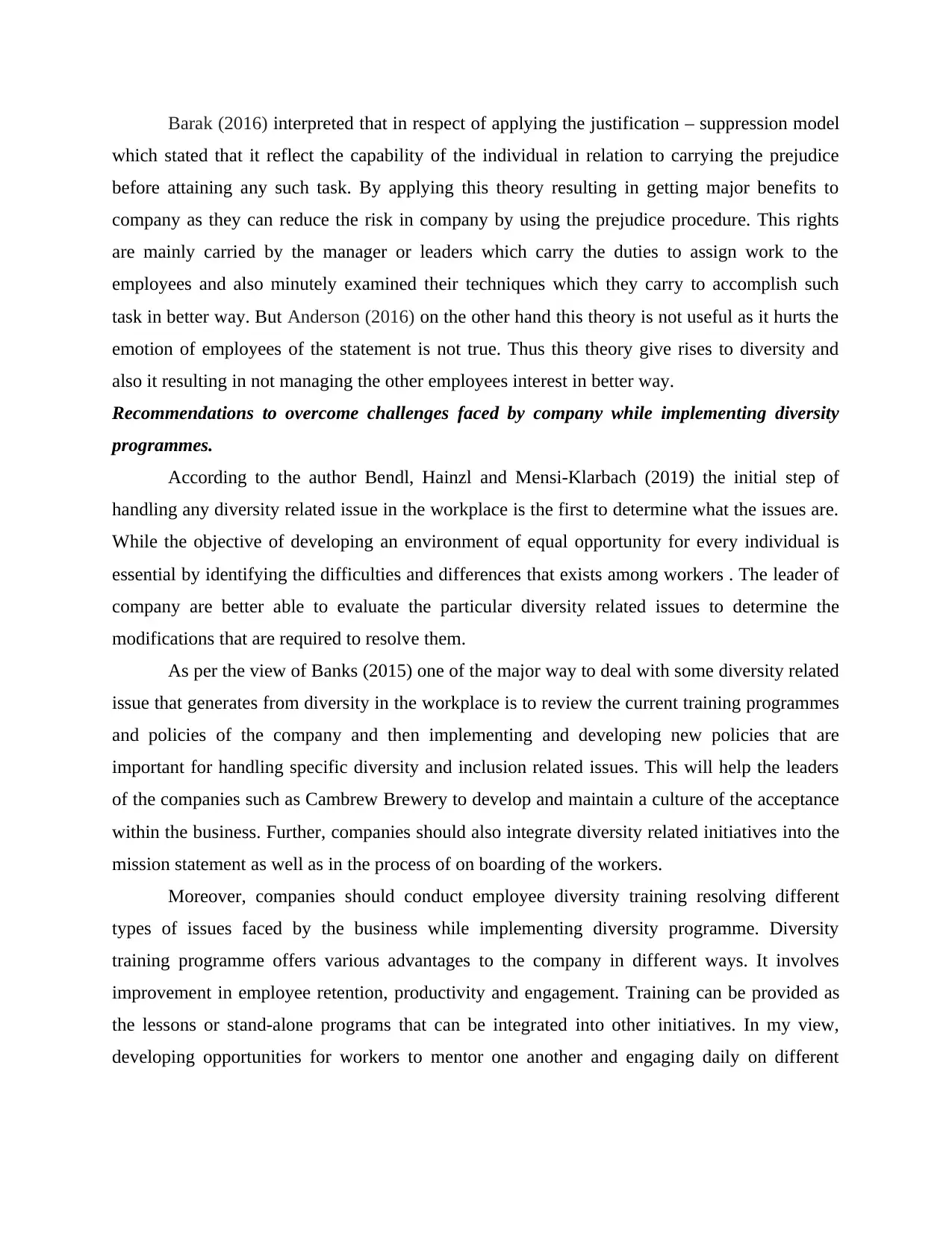
Barak (2016) interpreted that in respect of applying the justification – suppression model
which stated that it reflect the capability of the individual in relation to carrying the prejudice
before attaining any such task. By applying this theory resulting in getting major benefits to
company as they can reduce the risk in company by using the prejudice procedure. This rights
are mainly carried by the manager or leaders which carry the duties to assign work to the
employees and also minutely examined their techniques which they carry to accomplish such
task in better way. But Anderson (2016) on the other hand this theory is not useful as it hurts the
emotion of employees of the statement is not true. Thus this theory give rises to diversity and
also it resulting in not managing the other employees interest in better way.
Recommendations to overcome challenges faced by company while implementing diversity
programmes.
According to the author Bendl, Hainzl and Mensi-Klarbach (2019) the initial step of
handling any diversity related issue in the workplace is the first to determine what the issues are.
While the objective of developing an environment of equal opportunity for every individual is
essential by identifying the difficulties and differences that exists among workers . The leader of
company are better able to evaluate the particular diversity related issues to determine the
modifications that are required to resolve them.
As per the view of Banks (2015) one of the major way to deal with some diversity related
issue that generates from diversity in the workplace is to review the current training programmes
and policies of the company and then implementing and developing new policies that are
important for handling specific diversity and inclusion related issues. This will help the leaders
of the companies such as Cambrew Brewery to develop and maintain a culture of the acceptance
within the business. Further, companies should also integrate diversity related initiatives into the
mission statement as well as in the process of on boarding of the workers.
Moreover, companies should conduct employee diversity training resolving different
types of issues faced by the business while implementing diversity programme. Diversity
training programme offers various advantages to the company in different ways. It involves
improvement in employee retention, productivity and engagement. Training can be provided as
the lessons or stand-alone programs that can be integrated into other initiatives. In my view,
developing opportunities for workers to mentor one another and engaging daily on different
which stated that it reflect the capability of the individual in relation to carrying the prejudice
before attaining any such task. By applying this theory resulting in getting major benefits to
company as they can reduce the risk in company by using the prejudice procedure. This rights
are mainly carried by the manager or leaders which carry the duties to assign work to the
employees and also minutely examined their techniques which they carry to accomplish such
task in better way. But Anderson (2016) on the other hand this theory is not useful as it hurts the
emotion of employees of the statement is not true. Thus this theory give rises to diversity and
also it resulting in not managing the other employees interest in better way.
Recommendations to overcome challenges faced by company while implementing diversity
programmes.
According to the author Bendl, Hainzl and Mensi-Klarbach (2019) the initial step of
handling any diversity related issue in the workplace is the first to determine what the issues are.
While the objective of developing an environment of equal opportunity for every individual is
essential by identifying the difficulties and differences that exists among workers . The leader of
company are better able to evaluate the particular diversity related issues to determine the
modifications that are required to resolve them.
As per the view of Banks (2015) one of the major way to deal with some diversity related
issue that generates from diversity in the workplace is to review the current training programmes
and policies of the company and then implementing and developing new policies that are
important for handling specific diversity and inclusion related issues. This will help the leaders
of the companies such as Cambrew Brewery to develop and maintain a culture of the acceptance
within the business. Further, companies should also integrate diversity related initiatives into the
mission statement as well as in the process of on boarding of the workers.
Moreover, companies should conduct employee diversity training resolving different
types of issues faced by the business while implementing diversity programme. Diversity
training programme offers various advantages to the company in different ways. It involves
improvement in employee retention, productivity and engagement. Training can be provided as
the lessons or stand-alone programs that can be integrated into other initiatives. In my view,
developing opportunities for workers to mentor one another and engaging daily on different
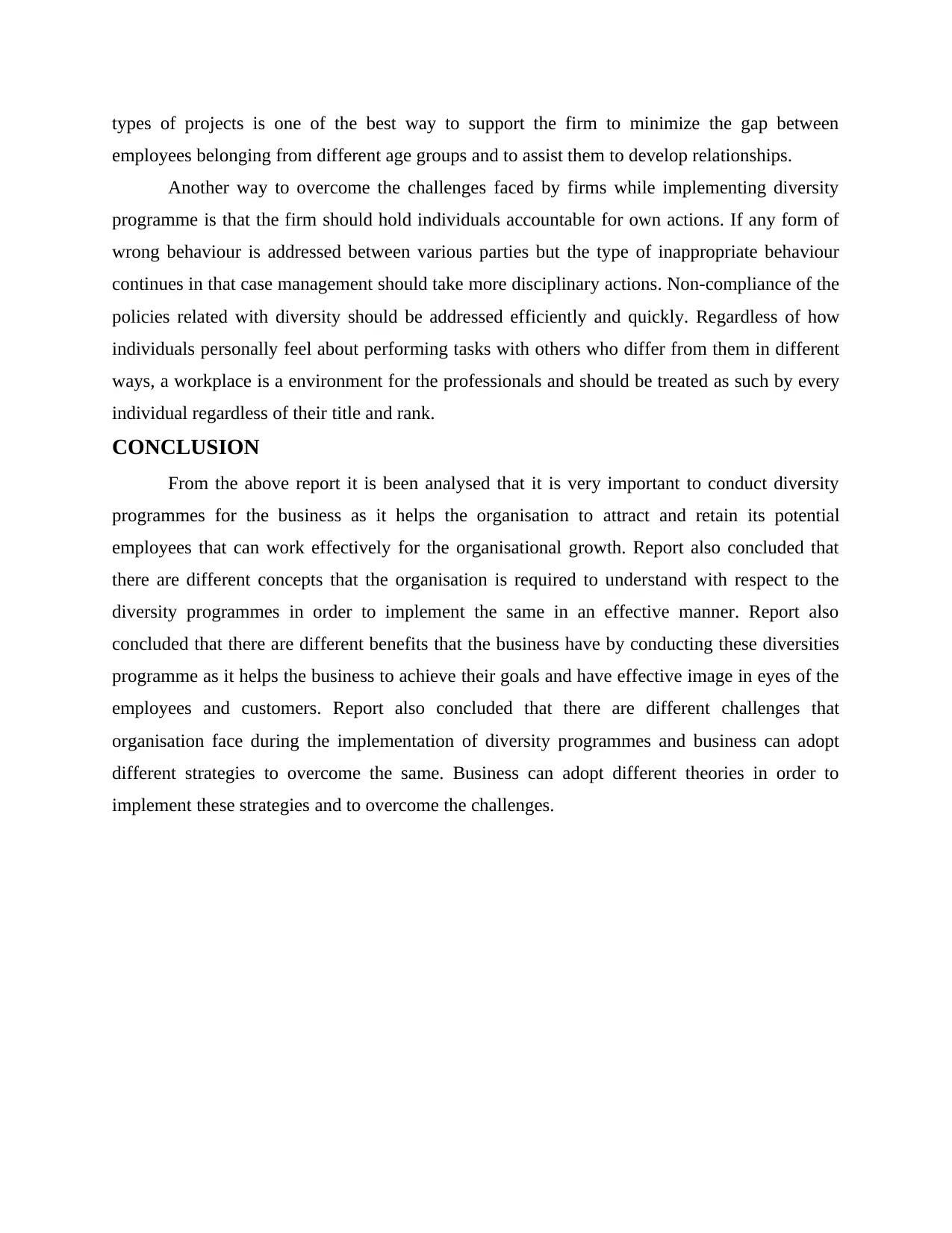
types of projects is one of the best way to support the firm to minimize the gap between
employees belonging from different age groups and to assist them to develop relationships.
Another way to overcome the challenges faced by firms while implementing diversity
programme is that the firm should hold individuals accountable for own actions. If any form of
wrong behaviour is addressed between various parties but the type of inappropriate behaviour
continues in that case management should take more disciplinary actions. Non-compliance of the
policies related with diversity should be addressed efficiently and quickly. Regardless of how
individuals personally feel about performing tasks with others who differ from them in different
ways, a workplace is a environment for the professionals and should be treated as such by every
individual regardless of their title and rank.
CONCLUSION
From the above report it is been analysed that it is very important to conduct diversity
programmes for the business as it helps the organisation to attract and retain its potential
employees that can work effectively for the organisational growth. Report also concluded that
there are different concepts that the organisation is required to understand with respect to the
diversity programmes in order to implement the same in an effective manner. Report also
concluded that there are different benefits that the business have by conducting these diversities
programme as it helps the business to achieve their goals and have effective image in eyes of the
employees and customers. Report also concluded that there are different challenges that
organisation face during the implementation of diversity programmes and business can adopt
different strategies to overcome the same. Business can adopt different theories in order to
implement these strategies and to overcome the challenges.
employees belonging from different age groups and to assist them to develop relationships.
Another way to overcome the challenges faced by firms while implementing diversity
programme is that the firm should hold individuals accountable for own actions. If any form of
wrong behaviour is addressed between various parties but the type of inappropriate behaviour
continues in that case management should take more disciplinary actions. Non-compliance of the
policies related with diversity should be addressed efficiently and quickly. Regardless of how
individuals personally feel about performing tasks with others who differ from them in different
ways, a workplace is a environment for the professionals and should be treated as such by every
individual regardless of their title and rank.
CONCLUSION
From the above report it is been analysed that it is very important to conduct diversity
programmes for the business as it helps the organisation to attract and retain its potential
employees that can work effectively for the organisational growth. Report also concluded that
there are different concepts that the organisation is required to understand with respect to the
diversity programmes in order to implement the same in an effective manner. Report also
concluded that there are different benefits that the business have by conducting these diversities
programme as it helps the business to achieve their goals and have effective image in eyes of the
employees and customers. Report also concluded that there are different challenges that
organisation face during the implementation of diversity programmes and business can adopt
different strategies to overcome the same. Business can adopt different theories in order to
implement these strategies and to overcome the challenges.
⊘ This is a preview!⊘
Do you want full access?
Subscribe today to unlock all pages.

Trusted by 1+ million students worldwide
1 out of 15
Related Documents
Your All-in-One AI-Powered Toolkit for Academic Success.
+13062052269
info@desklib.com
Available 24*7 on WhatsApp / Email
![[object Object]](/_next/static/media/star-bottom.7253800d.svg)
Unlock your academic potential
Copyright © 2020–2025 A2Z Services. All Rights Reserved. Developed and managed by ZUCOL.




